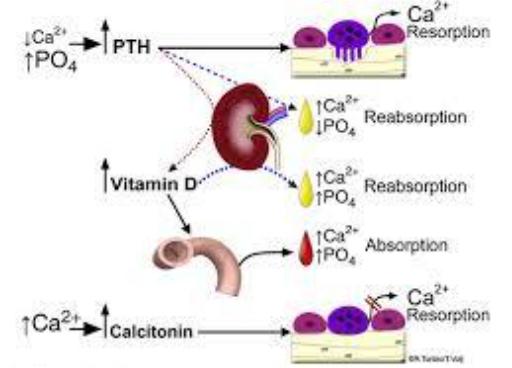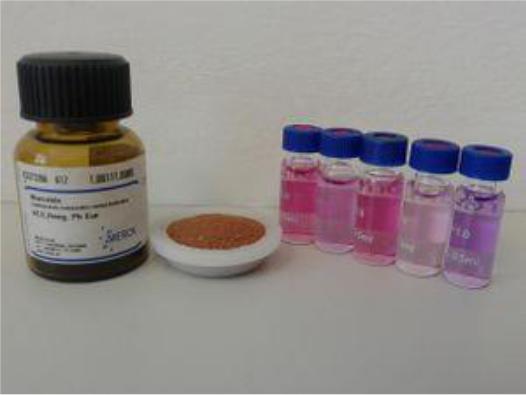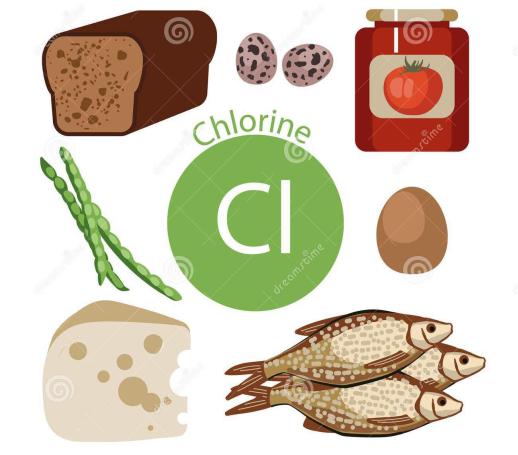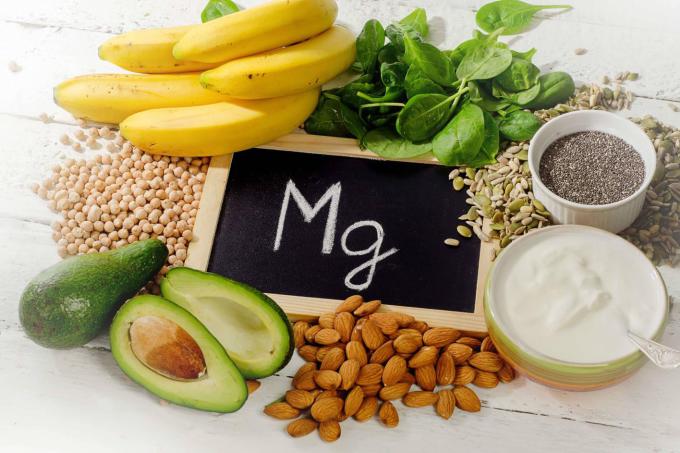
English Lectures / Functional chemistry 1 eng
.pdf
Mechanisms of phosphorus-calcium metabolism
1.parathyroid glands with a high phosphate content (with a low level of calcium) secrete parathyroid hormone, which destroys bone tissue, thereby increasing the concentration of calcium.
2.with a high level of calcium in the blood, the thyroid gland produces calcitonin, which causes the movement of calcium from the blood to the bones,
3.the hormone of the parathyroid glands activates vitamin D, increasing the absorption of calcium in the digestive tract and the reverse absorption of the cation in the kidneys.

Quantitative determination of serum calcium
The principle of the method is based on the ability of serum calcium to give a red complex compound in an alkaline environment with a solution of glyoxal-bis-2-hydroxy-nilin. The intensity of developing staining is proportional to the calcium content.

Quantitative determination of calcium in serum by titrometric method
The principle of the method is based on the ability of the murexide indicator to form a complex compound colored in red-violet or pale pink (depending on concentration) with calcium ions in an alkaline medium. When titrated with a solution of a stronger complexing agent, this complex is destroyed, and the bound murexide is released, which leads to the appearance of its initial color (purple or pale lilac).

Chlorides
Chlorine (95-103 mmol/L) is one of the main chemical elements in the human body that performs a variety of physiological functions and is part of a large number of biologically active substances (part of the gastric juice, participates in water-salt metabolism, helps water retain tissue)
Chlorine and sodium |
Let’s write! |
Chlorine is involved in the regulation of the amount of fluid in the body and maintains an acid-base balance.
•Typically, changes in chlorine concentration are similar to changes in sodium in the body: increases and decreases occur for similar reasons.
•In case of violations in the acid-base balance, the chlorine concentration can vary regardless of the sodium concentration, acting as an independent buffer system. This helps maintain a constant bioelectric potential at the cellular level due to the movement of charged molecules.
Chlorine decrease |
Let’s write! |
•Chlorine is ingested with food and salt, consisting of a compound of sodium and chlorine.
•Most of the chlorine absorbed in the gastrointestinal tract is excreted in the urine.
•Chlorine is secreted with other cations during increased urine output and is lost from the digestive tract during vomiting, diarrhea, or the appearance of intestinal fistulas. The level of chlorine in the body is usually constant, although it decreases slightly after eating.
•With metabolic acidosis, while raising the concentration of chlorine, the level of bicarbonate decreases. Similarly, the production of aldosterone directly causes an increase in the reverse absorption of sodium and indirectly affects the absorption of chlorine.

Количественное определение хлоридов крови по методу Банта
The principle of the method is based on titration of blood chlorides with a solution of silver nitrate in the presence of an indicator of potassium dichromate.

Magnesium
Magnesium (0.75-1.25 mmol/L) – refers to the indispensable nutritional factors. The daily requirement is 0.2-0.3 g / day. It contains intracellular magnesium and is involved in the creation of intracellular osmotic pressure.
The role of magnesium:
1.A component of skeleton bones and teeth.
2.Activator of a number of enzyme systems (glycolysis, β-oxidation of fatty
acids, metabolism of phosphoglycerides, amino acids).
3. Participates in DNA repair.
The main ways to remove magnesium: kidneys and intestines. In the blood plasma, magnesium is present in 2 forms: ionized magnesium - 80% and bound to proteins - 20%.
Magnesium increase |
Let’s write! |
Hypermagnesemia (greater than 1.25 mmol/L) occurs in chronic renal failure, with atherosclerosis.
Magnesium decrease |
Let’s write! |
Disorders of magnesium metabolism: in clinical practice, hypomagnesemia (<0.75 mmol/L) is more common. It occurs with:
•an excessive loss of magnesium (with diarrhea)
•a lack of magnesium in food,
•toxicosis of pregnant women,
•cancer,
•chronic heart failure.
Manifested by a violation of neuromuscular tone (muscle tremors, tetany), confusion.
